The Effect of Different Moderate Thermal Modification Durations on the Wood Properties of American Alder
Abstract
:1. Introduction
2. Materials and Methods
2.1. Materials
2.2. Equipment and Instruments
2.3. Thermal Modification
2.4. Density in Absolute Dry Stage
2.5. Residual Stress of Wood
2.6. Mechanical Strength
2.7. Moisture Adsorption and Water Uptake
2.8. Dimensional Stability
2.9. Colour Measurements
2.10. Statistical Analysis
3. Results and Discussion
3.1. Density in the Absolute Dry Stage
3.2. Residual Stress of Wood
3.3. Mechanical Strength
3.4. Moisture Adsorption and Water Uptake
3.5. Dimensional Stability
3.6. Colour Changes
4. Conclusions
Author Contributions
Funding
Institutional Review Board Statement
Informed Consent Statement
Data Availability Statement
Conflicts of Interest
References
- Huang, Y.J.; Zhang, Y.F.; Wang, Z.; Dauletbe, A.; Lu, Y.; Shen, Z. Analysis of crack expansion and morphology of cross-laminated timber planar shear test. J. Renew. Mater. 2022, 10, 849. [Google Scholar] [CrossRef]
- Zhao, X.Y.; Huang, Y.J.; Fu, H.Y.; Wang, Y.L.; Wang, Z.; Sayed, U. Deflection test and modal analysis of lightweight timber floors. J. Bioresour. Bioprod. 2021, 6, 266–278. [Google Scholar] [CrossRef]
- Yang, L. Effect of temperature and pressure of supercritical CO2 on dewatering, shrinkage and stresses of Eucalyptus Wood. Appl. Sci. 2021, 11, 8730. [Google Scholar] [CrossRef]
- Fang, L.; Zeng, J.; Zhang, X.; Wang, D. Effect of veneer initial moisture content on the performance of polyethylene film reinforced decorative veneer. Forests 2021, 12, 102. [Google Scholar] [CrossRef]
- Wang, Z.; Liu, J.L.; Sun, B.L.; Cao, J.Z. Study on mechanism of moisture absorption change of larch plantation under vacuum heat treatment. Spectrosc. Spectr. Anal. 2017, 37, 3160–3164. [Google Scholar]
- Bi, W.Z.; Li, H.T.; Hui, D.; Gaff, M.; Lorenzo, R.; Corbi, I.; Corbi, O.; Ashraf, M. Effects of chemical modification and nanotechnology on wood properties. Nanotechnol. Rev. 2021, 10, 978–1008. [Google Scholar] [CrossRef]
- Zhou, T.; Liu, H.H. Research progress of wood cell wall modification and functional improvement: A review. Materials 2022, 15, 1598. [Google Scholar] [CrossRef]
- Gao, Y.Q.; Li, Y.Y.; Ren, R.Q.; Chen, Y.; Gao, J.M. Effect of weak acid modification on the structure and properties of heat-treated Chinese fir. J. For. Eng. 2021, 6, 49–55. [Google Scholar]
- Liu, X.Y.; Tu, X.W.; Liu, M. Effects of light thermal treatments on the color, hygroscopity and dimensional stability of wood. Wood Res. 2021, 66, 95–103. [Google Scholar] [CrossRef]
- Zhang, N.N.; Xu, M.; Cai, L.P. Improvement of mechanical, humidity resistance and thermal properties of heat-treated rubber wood by impregnation of SiO2 precursor. Sci. Rep. 2019, 9, 1–9. [Google Scholar] [CrossRef] [PubMed] [Green Version]
- Spear, M.J.; Curling, S.F.; Dimitriou, A.; Ormondroyd, G.A. Review of functional treatments for modified wood. Coatings 2021, 11, 327. [Google Scholar] [CrossRef]
- Liu, X.; Timar, M.C.; Varodi, A.M.; Nedelcu, R.; Torcătoru, M.-J. Colour and surface chemistry changes of wood surfaces coated with two types of waxes after seven years exposure to natural light in indoor conditions. Coatings 2022, 12, 1689. [Google Scholar] [CrossRef]
- Zhang, L.; Chen, Z.H.; Dong, H.R.; Fu, S.; Ma, L.; Yang, X.J. Wood plastic composites based wood wall’s structure and thermal Insulation performance. J. Bioresour. Bioprod. 2021, 6, 65–74. [Google Scholar] [CrossRef]
- Gu, L.B.; Ding, T. Production and application of thermal-modified wood. China Wood Based Panels 2008, 9, 14–18. [Google Scholar]
- Zhou, Y.Q.; Xue, Z.Q.; Huang, Q.T.; Yao, B.; Wang, X.H. Physical and mechanical properties of Aucoumea klaineana wood after vacuum heat treatment for furniture components. J. For. Eng. 2020, 5, 73–78. [Google Scholar]
- Kocaefe, D.; Ponscak, S.; Boluk, Y. Effect of thermal treatment on the chemical composition and mechanical properties of birch and aspen. BioResources 2008, 3, 517–553. [Google Scholar]
- Hakkou, M.; Petrissans, M.; Gerardinp, E. Investigations of the reasons for fungal durability of heat-treated beech wood. Polym. Degrad. Stabil. 2006, 91, 393–397. [Google Scholar] [CrossRef]
- Yang, L.; Han, T.Q.; Fu, Y.D. Effect of heat treatment and wax impregnation on dimensional stability of pterocarpus Macrocarpus wood. Wood Res. 2020, 65, 963–974. [Google Scholar] [CrossRef]
- Yang, L.; Jin, H.H. Effect of heat treatment on the physic-mechanical characteristics of Eucalyptusurophylla S.T. Blake. Materials 2021, 14, 6643. [Google Scholar] [CrossRef]
- Fang, L.; Xiong, X.Q.; Wang, X.H.; Chen, H.; Mo, X.F. Effects of surface modification methods on mechanical and interfacial properties of high-density polyethylene-bonded wood veneer composites. J. Wood Sci. 2017, 63, 65–73. [Google Scholar] [CrossRef] [Green Version]
- Fu, Z.Y.; Zhou, Y.D.; Gao, X.; Liu, H.; Zhou, F. Changes of water related properties in radiata pine wood due to heat treatment. Constr. Build. Mater. 2019, 227, 116692. [Google Scholar] [CrossRef]
- Hosseinpourpia, R.; Mai, C. Mode of action of brown rot decay resistance of thermally modified wood: Resistance to Fenton’s reagent. Holzforschung 2016, 70, 691–697. [Google Scholar] [CrossRef]
- Yang, L.; Han, T.Q.; Liu, Y.X.; Yin, Q. Effects of vacuum heat treatment and wax impregnation on the color of pterocarpus macrocarpus kurz. Bioresources 2021, 16, 954–963. [Google Scholar] [CrossRef]
- Cao, Y.J.; Li, X.W.; Wang, S.; Li, Y.X.; Li, W.J. Effects of thermal treatment on color in eucalyptus urophylla wood. For. Environ. Sci. 2018, 34, 18–20. [Google Scholar]
- Klement, I.; Marko, P. Colour changes of beech wood (Fagus sylvatica L.) during high temperature drying process. Wood Res. 2009, 54, 45–54. [Google Scholar]
- Sedlar, T.; Sinkovic, T.; Peric, I.; Jarc, A.; Stojnic, S.; Sefc, B. Hardness of thermally modified beech wood and hornbeam wood. Sumar. List 2019, 143, 425–433. [Google Scholar]
- Kubojima, Y.; Okano, T.; Ohta, M. Bending strength and toughness of heat-treated wood. J. Wood Sci. 2000, 46, 8–15. [Google Scholar] [CrossRef]
- Feng, X.H.; Chen, J.Y.; Yu, S.X.; Wu, Z.H.; Huang, Q.T. Mild hydrothermal modification of beech wood (Zelkova schneideriana Hand-Mzt): Its physical, structural, and mechanical properties. Eur. J. Wood Wood Prod. 2022, 80, 933–945. [Google Scholar] [CrossRef]
- Ager, A.A.; Heilman, P.E.; Stettler, R.F. Genetic variation in red alder (Alnus rubra) in relation to native climate and geography. Can. J. Forest Res. 1993, 23, 1930–1939. [Google Scholar] [CrossRef]
- Lowell, E.C.; Krahmer, R.L. Effects of lean in red alder trees on wood shrinkage and density. Wood Fiber Sci. 1993, 25, 2–7. [Google Scholar]
- Forsthuber, B.; Illy, A.; Grull, G. Photo-scanning colorimetry of wood and transparent wood coatings. Eur. J. Wood Wood Prod. 2014, 72, 487–495. [Google Scholar] [CrossRef]
- Zhang, J.Y.; Chesnokova, T.; Zhang, B.Y.; Zhan, J.F. Chromatic variability of larch wood impacted by high-temperature thermal treatment and oil-wax coating. J. For. Eng. 2020, 5, 64–75. [Google Scholar]
- Liu, X.Y. The Properties Changes and Classification Explore of Heat Treatment Wood; Chinese Academy of Forestry: Beijing, China, 2010. [Google Scholar]
- Nogi, M.; Yamamoto, H.; Okuyama, T. Relaxation mechanism of residual stress inside logs by heat treatment: Choosing the heating time and temperature. J. Wood Sci. 2003, 49, 22–28. [Google Scholar] [CrossRef]
- Iida, I.; Murase, K.; Ishimaru, Y. Stress relaxation of wood during the elevating and lowering processes of temperature and the set after relaxation. J. Wood Sci. 2002, 48, 8–13. [Google Scholar] [CrossRef]
- Dwianto, W.; Morooka, T.; Norimoto, M. Method for measuring viscoelastic properties of wood under high temperature and high pressure steam conditions. J. Wood Sci. 1999, 45, 373–377. [Google Scholar] [CrossRef]
- Dwianto, W.; Morooka, T.; Norimoto, M. The compressive stress relaxation of Albizia (Paraserienthes falcata Becker) wood during heat treatment. Mokuzai Gakkaishi 1998, 44, 403–409. [Google Scholar]
- Kucerova, V.; Lagana, R.; Vybohova, E.; Hyrosova, T. The effect of chemical changes during heat treatment on the color and mechanical properties of fir wood. Bioresources 2016, 11, 9079–9094. [Google Scholar] [CrossRef]
- Yan, M.H. Wood Properties and Dynamic Moisture Sorption of High-Temperature Thermlly Treated Larch gmelinii; Northeast Forestry University: Harbin, China, 2021. [Google Scholar]
- Yang, T.H.; Lee, C.H.; Lee, C.J.; Cheng, Y.W. Effects of different thermal modification media on physical and mechanical properties of moso bamboo. Constr. Build. Mater. 2016, 119, 251–259. [Google Scholar] [CrossRef]
- Altgen, M.; Willems, W.; Hosseinpourpia, R.; Rautkari, L. Hydroxyl accessibility and dimensional changes of Scots pine sapwood affected by alterations in the cell wall ultrastructure during heat-treatment. Polym. Degrad. Stabil. 2018, 152, 244–252. [Google Scholar] [CrossRef]
- Wang, Z.; Sun, B.L.; Liu, J.L. Effect of thermo-vacuum treatment on the color and chemistry of larch wood. Bioresources 2016, 11, 2349–2360. [Google Scholar] [CrossRef] [Green Version]
- Gao, X.; Zhou, F.; Zhou, Y.D. Sorption isotherms characteristics of high temperature heat-treated wood. Sci. Silvae Sin. 2019, 55, 119–127. [Google Scholar]
- Willems, W.; Altgen, M.; Rautkari, L. A molecular model for reversible and irreversible hygroscopicity changes by thermal wood modification. Holzforschung 2020, 74, 420–425. [Google Scholar] [CrossRef]
- Liu, H.H.; Yang, L.; Wu, Z.H.; Cai, Y.C.; Li, X.C. Study on radio-frequency vacuum drying of three rosewood thin boards. J. For. Eng. 2017, 2, 15–19. [Google Scholar]
- Kamperidou, V.; Barboutis, I.; Vasileiou, V. Response of colour and hygroscopic properties of Scots pine wood to thermal treatment. J. For. Res. 2013, 24, 571–575. [Google Scholar] [CrossRef]
- Sundqvist, B. Colour Changes and Acid Formation in Wood During Heating. Ph.D. Thesis, Luleå Tekniska Universitet, Norrbotten, Sweden, 2004. [Google Scholar]
- Liu, Y.; Hu, J.; Wu, Z. Fabrication of coatings with structural color on a wood surface. Coatings 2020, 10, 32. [Google Scholar] [CrossRef] [Green Version]
- Jankowska, A.; Kozakiewicz, P. Influence of thermal modification of Scots pine wood (Pinus sylvestris L.) on color changes. Ann. Wars. Univ. Life Sci. SGGW For. Wood Technol. 2014, 88, 92–96. [Google Scholar]
- Esteves, B.; Velez Marques, A.; Domingos, I.; Pereira, H. Heat-induced colour changes of pine (Pinus pinaster) and eucalypt (Eucalyptus globulus) wood. Wood Sci. Technol. 2007, 42, 369–384. [Google Scholar] [CrossRef]
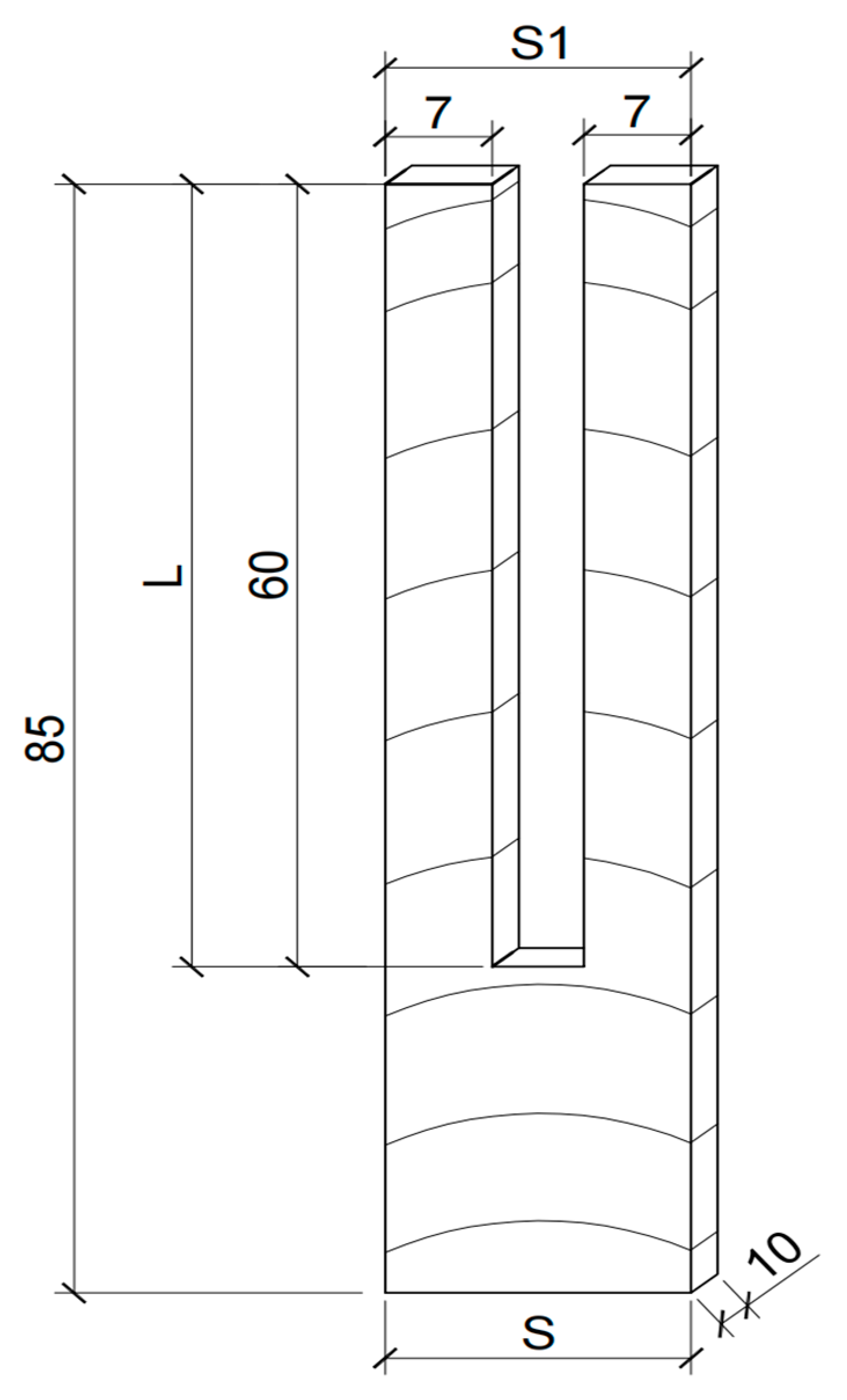
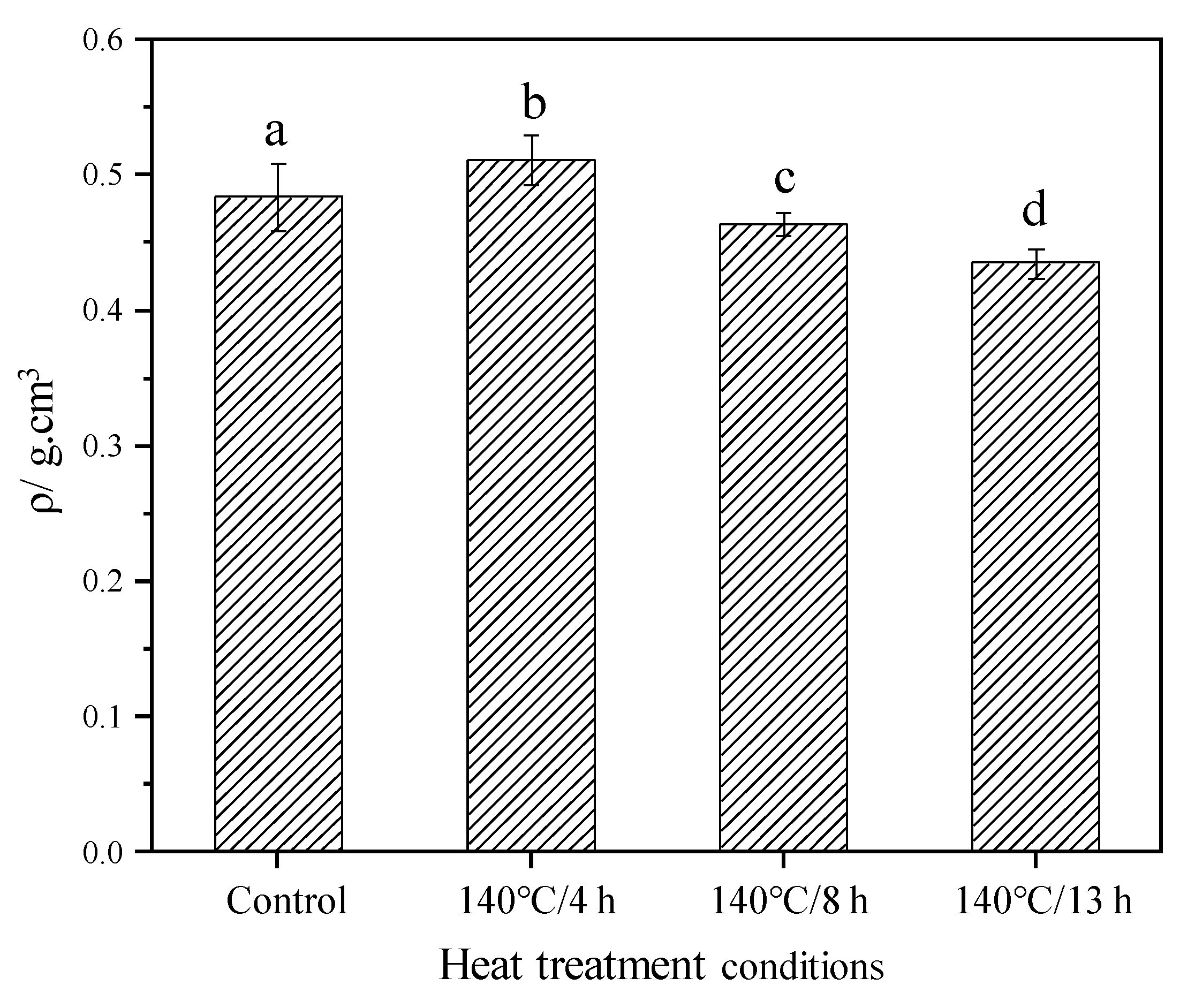
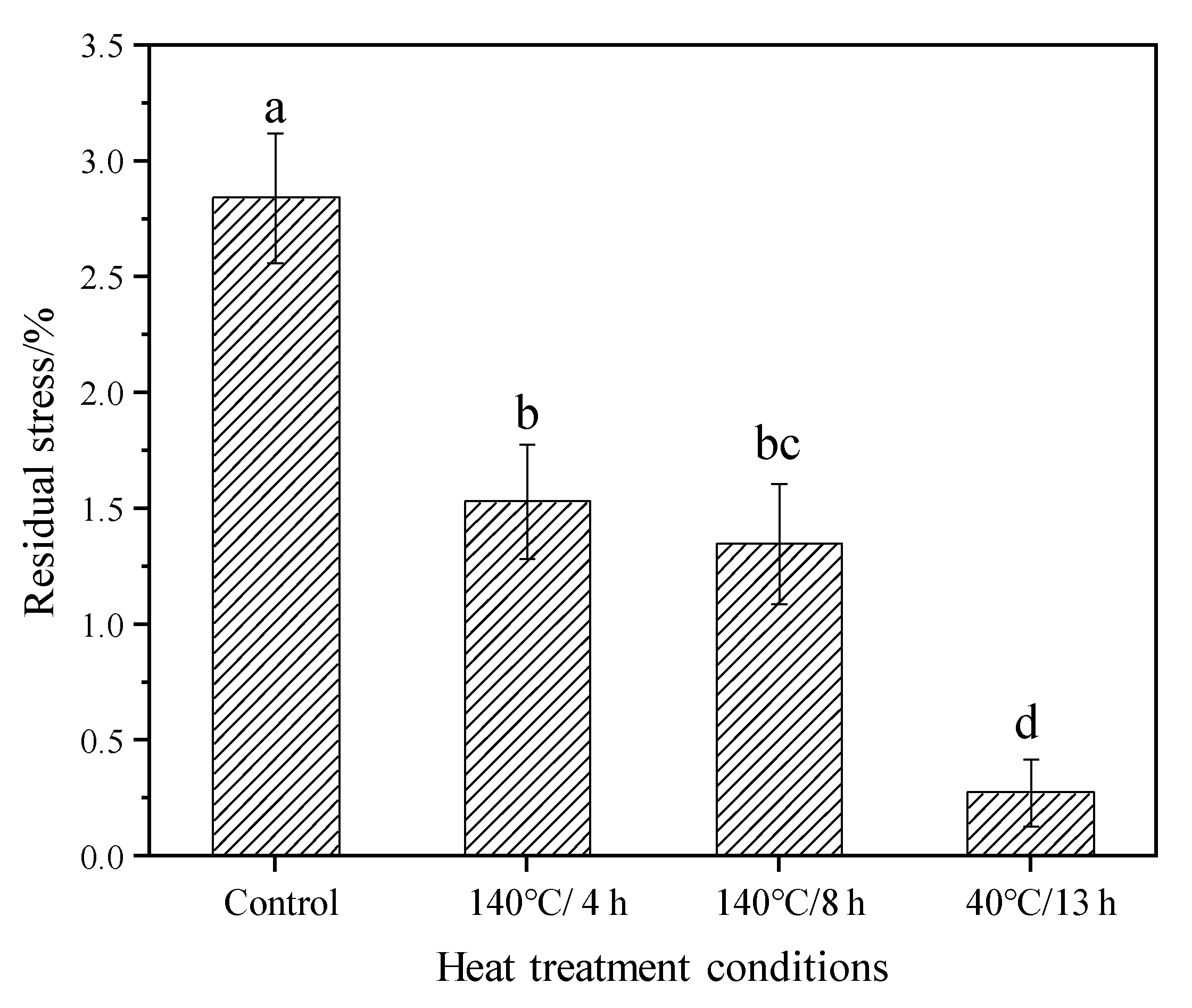
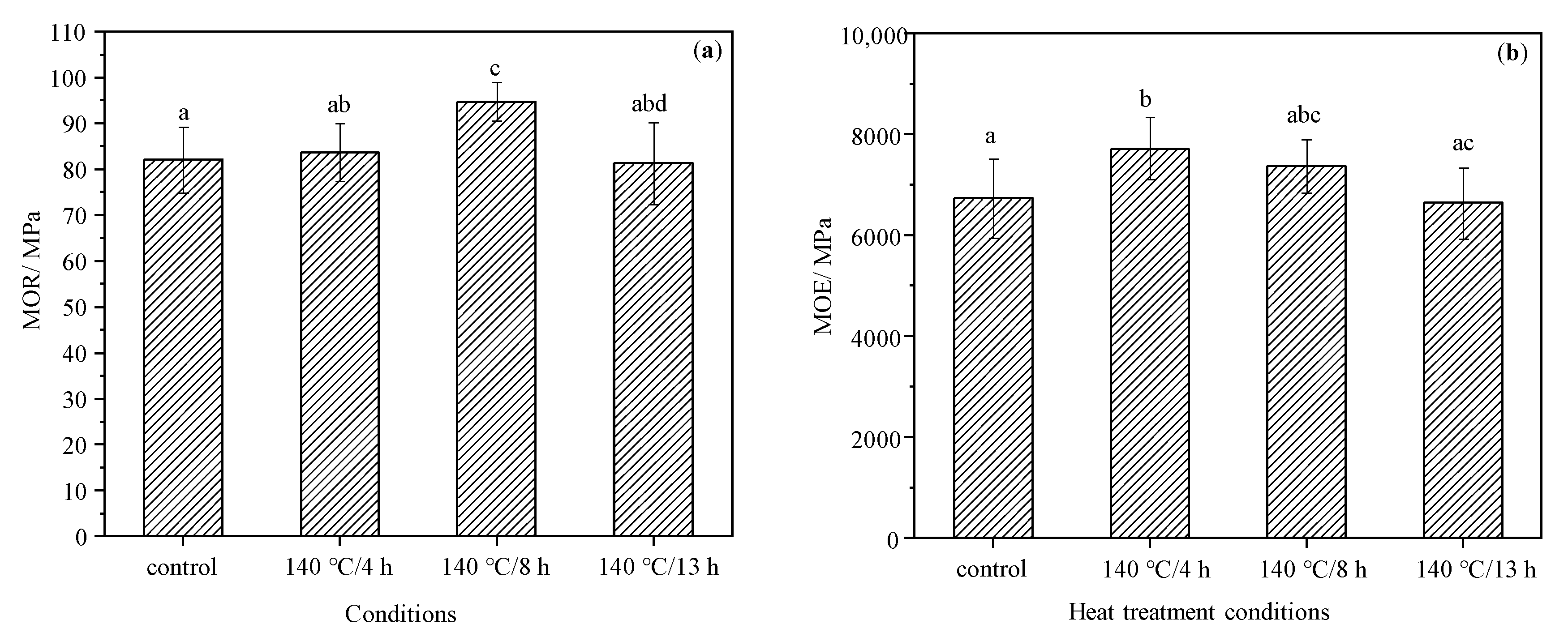
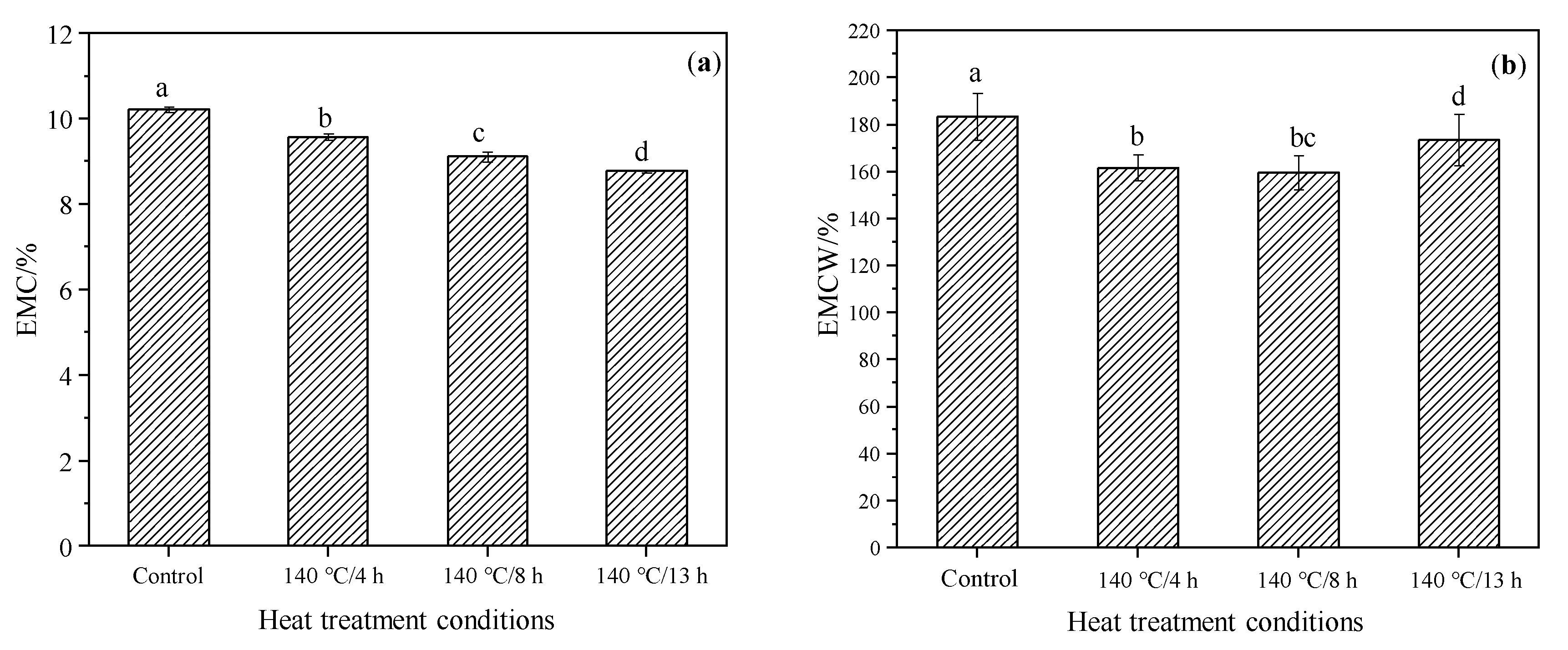
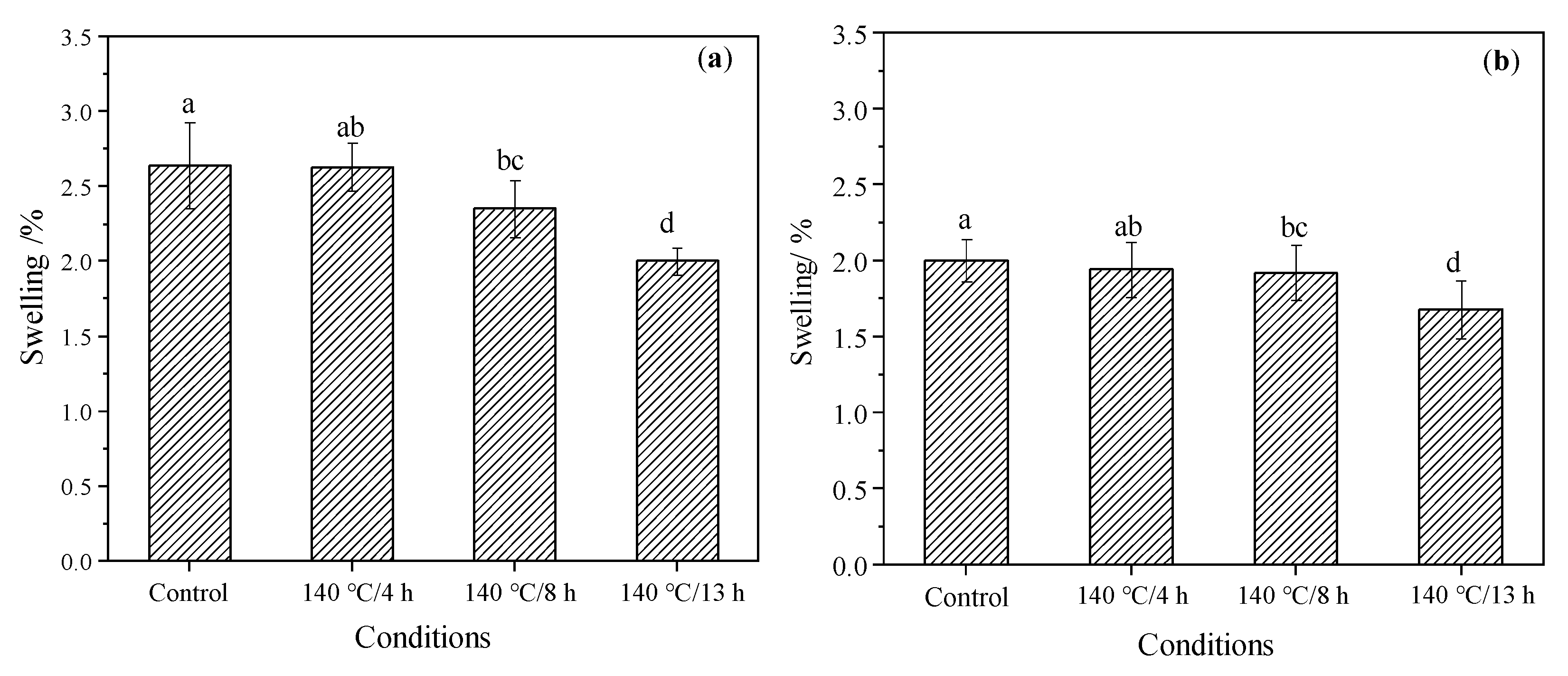

| Schedules | Stages | Initial T. (°C) | Aimed T. (°C) | Relative Humidity (%) | Time (h) |
|---|---|---|---|---|---|
| A | Drying | 40 | 140 | 65 | 30 |
| Treating | 140 | 140 | 100 | 13 | |
| Cooling | 140 | 60 | 100 | 5 | |
| B C | Slow drying | 40 | 80 | 75 | 4 |
| Fast drying | 80 | 100 | 30 | 2 | |
| Treating (B) | 100 | 140 | 100 | 4 | |
| Treating (C) | 100 | 140 | 100 | 8 | |
| Cooling | 140 | 60 | 100 | 5 |
| Treating Conditions | ΔL* | Δa* | Δb* | ΔE* | |
|---|---|---|---|---|---|
| Temperature/°C | Time/h | ||||
| 140 | 4 | −1.25 a | 0.08 a | 0.67 a | 1.65 a |
| 140 | 8 | −0.38 a | 1.06 b | 2.88 b | 3.59 b |
| 140 | 13 | −2.91 b | 0.63 b | 2.38 b | 3.53 b |
Publisher’s Note: MDPI stays neutral with regard to jurisdictional claims in published maps and institutional affiliations. |
© 2022 by the authors. Licensee MDPI, Basel, Switzerland. This article is an open access article distributed under the terms and conditions of the Creative Commons Attribution (CC BY) license (https://creativecommons.org/licenses/by/4.0/).
Share and Cite
Liu, H.; Li, Z.; Zhang, X.; Tang, B.; Wan, C.; Wang, K. The Effect of Different Moderate Thermal Modification Durations on the Wood Properties of American Alder. Materials 2022, 15, 8839. https://doi.org/10.3390/ma15248839
Liu H, Li Z, Zhang X, Tang B, Wan C, Wang K. The Effect of Different Moderate Thermal Modification Durations on the Wood Properties of American Alder. Materials. 2022; 15(24):8839. https://doi.org/10.3390/ma15248839
Chicago/Turabian StyleLiu, Honghai, Zhilan Li, Xiaokai Zhang, Bin Tang, Chuan Wan, and Kemin Wang. 2022. "The Effect of Different Moderate Thermal Modification Durations on the Wood Properties of American Alder" Materials 15, no. 24: 8839. https://doi.org/10.3390/ma15248839





